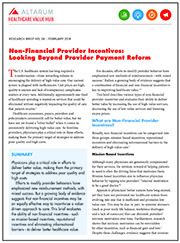Improving Value
Provider-Facing Incentives
As frontline providers, physicians play a critical role in delivering high-value care, making them the primary target of strategies to address poor quality and high costs. Incentives to change providers' practice or pricing behaviors can be divided into two categories: financial and non-financial.
Efforts to modify provider behavior have traditionally emphasized financial incentives — with mixed success.1 Rather, a growing body of evidence suggests that a combination of financial and non-financial incentives is key to improving healthcare value.2,3
Financial Incentives
Financial incentives aim to change providers' behavior by paying them differently. Alternative payment models that hold providers accountable for delivering higher quality and/or lower cost care include bundled payments, capitation, global budgets, shared savings and Pay-for-Performance.
More information on financial incentives can be found here.
Non-Financial Incentives
Non-financial incentives can also take a variety of forms. They can be mission-based (tapping into providers' internal motivation to be a good doctor); reputational (leveraging physicians' desire for respect and positive recognition); or practical (eliminating informational barriers to the delivery of high-value care). Reputational incentives, in the form of peer comparisons or price/quality transparency, are the most widely studied to-date.
More information on non-financial incentives can be found here.
Notes
1. Damberg, Cheryl L., et al., "Measuring Success in Health Care Value-Based Purchasing Programs: Findings From an Environmental Scan, Literature Review, and Expert Panel Discussions," RAND Corporations, Santa Monica, CA (2014).
2. Navathe, Amol S., et al., "Into Practice: How Advocate Health System Uses Behavioral Economics to Motivate Physicians in Its Incentive Program," The Commonwealth Fund (August 3, 2016).
3. Khullar, Dhruv, and Dana G. Safran, "Using Behavioral Economics in Provider Payment to Motivate Improved Quality, Outcomes & Cost: The Alternative Quality Contract," Healthcare, Vol. 4, No. 1-2 (March 2017).








